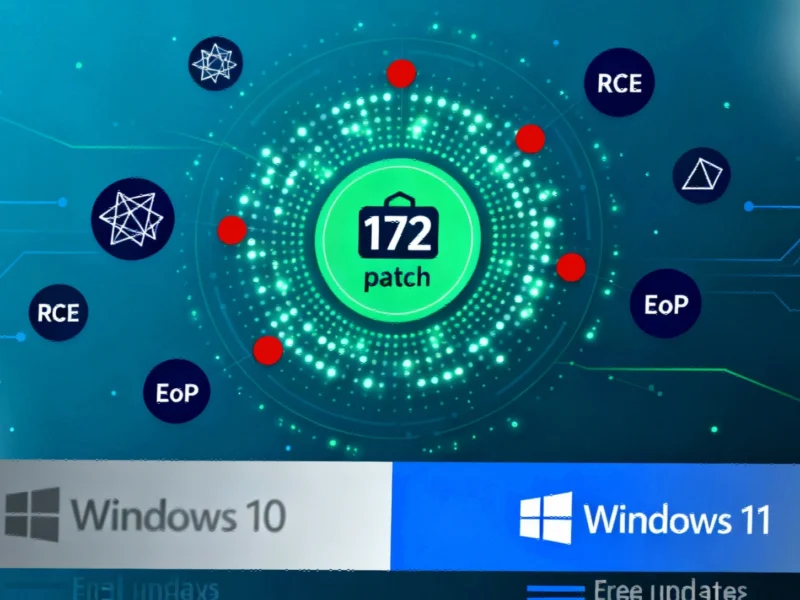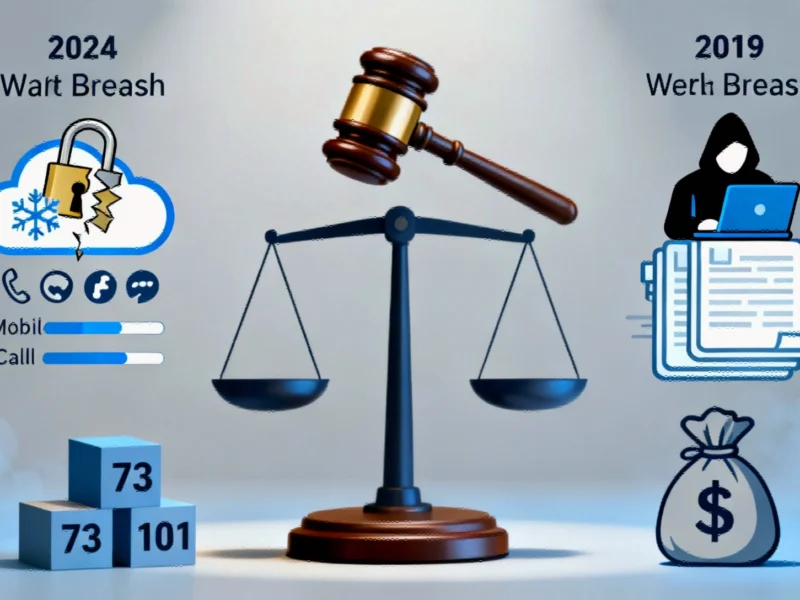Unprecedented Patch Tuesday Addresses Critical Infrastructure Vulnerabilities
Microsoft has deployed one of its most substantial security updates in recent history, addressing 172 distinct security vulnerabilities during October 2025’s Patch Tuesday cycle. This comprehensive security overhaul includes six zero-day vulnerabilities that were either publicly disclosed or actively exploited in the wild. The update arrives at a critical juncture for industrial computing systems, as organizations must now navigate both immediate security threats and the end of Windows 10 support. According to detailed analysis from security researchers, the scale of this update underscores the evolving threat landscape facing industrial control systems and enterprise networks.
Critical Vulnerability Breakdown
Among the 172 patched vulnerabilities, eight received Microsoft’s highest “Critical” severity rating. These include five remote code execution vulnerabilities that could allow attackers to run arbitrary code on affected systems without user interaction, and three elevation of privilege issues that could grant attackers administrative access. The complete vulnerability distribution reveals:
- 80 elevation of privilege vulnerabilities – representing nearly half of all patched flaws
- 31 remote code execution vulnerabilities – posing significant risk to industrial systems
- 28 information disclosure vulnerabilities – potentially exposing sensitive operational data
- 11 security feature bypass vulnerabilities – undermining core protection mechanisms
- 11 denial of service vulnerabilities – threatening operational continuity
- 10 spoofing vulnerabilities – enabling identity and system impersonation
Zero-Day Vulnerabilities Demand Immediate Attention
The six zero-day vulnerabilities represent the most urgent patching priorities for industrial computing environments. Two were publicly disclosed before patches were available, while three others were actively exploited by threat actors.
CVE-2025-24990 and CVE-2025-24052 – Windows Agere Modem Driver Privilege Escalation
Microsoft took the extraordinary step of completely removing the vulnerable Agere Modem driver (ltmdm64.sys) from supported Windows operating systems. This driver, which shipped natively with Windows, allowed attackers to gain administrative privileges regardless of whether the modem hardware was actively in use. The removal will disable related Fax modem functionality, but Microsoft deemed this necessary given the severity of the vulnerability discovered by researchers Fabian Mosch and Jordan Jay.
CVE-2025-59230 – Remote Access Connection Manager Privilege Escalation
This vulnerability in Windows Remote Access Connection Manager enabled authorized attackers to elevate privileges locally to SYSTEM level. Microsoft noted that exploitation requires “some measurable amount of effort,” but the potential impact on industrial systems managing remote access makes this a high-priority patch. The Microsoft Threat Intelligence Center (MSTIC) and Microsoft Security Response Center (MSRC) internally discovered and addressed this issue.
CVE-2025-47827 – Secure Boot Bypass in IGEL OS
Affecting IGEL OS versions before 11, this Secure Boot bypass vulnerability allowed attackers to mount crafted root filesystems from unverified images due to improper cryptographic signature verification in the igel-flash-driver module. Discovered by Zack Didcott and publicly disclosed on GitHub, this vulnerability threatens the integrity of boot processes in industrial computing environments.
Actively Exploited Vulnerabilities Require Urgent Patching
CVE-2025-0033 – AMD RMP Corruption During SNP Initialization
This sophisticated vulnerability affects AMD EPYC processors utilizing Secure Encrypted Virtualization with Secure Nested Paging (SEV-SNP). The race condition during Reverse Map Table (RMP) initialization could enable a compromised hypervisor to modify RMP entries before locking. While not exposing plaintext data, this vulnerability could compromise memory integrity in confidential computing environments. Researchers from ETH Zurich discovered the flaw, and Microsoft continues working on fixes for Azure Confidential Computing clusters.
CVE-2025-2884 – TCG TPM2.0 Implementation Vulnerability
This out-of-bounds read vulnerability in the Trusted Computing Group’s TPM 2.0 reference implementation could lead to information disclosure or denial of service. The flaw specifically affects the CryptHmacSign helper function, potentially undermining hardware-based security mechanisms critical to industrial computing systems. CERT/CC managed the disclosure process for this vulnerability attributed to both TCG and an anonymous researcher.
Windows 10 Reaches End of Security Support
This Patch Tuesday marks the final free security update for Windows 10, creating significant implications for industrial computing environments still running the operating system. Organizations must now decide between migrating to Windows 11 or purchasing Extended Security Updates (ESU). Microsoft offers ESU for one year to consumers and up to three years for enterprise customers, providing crucial breathing room for complex migration projects in industrial settings.
The timing of this transition coincides with broader industry developments, including ongoing technology licensing discussions that could impact software supply chains and geopolitical factors affecting technology deployment in critical infrastructure sectors.
Industrial Computing Implications and Complementary Updates
While Microsoft addresses Windows vulnerabilities, the broader industrial computing ecosystem continues to evolve. Recent developments include significant Linux graphics driver improvements that enhance performance in industrial visualization systems and Intel’s latest Linux kernel optimizations that deliver substantial performance gains for industrial workloads.
Security monitoring remains crucial, with resources like specialized security monitoring platforms providing additional layers of protection for industrial control systems. The convergence of these updates creates both challenges and opportunities for organizations managing complex industrial computing infrastructures.
Actionable Recommendations for Industrial Organizations
Industrial computing operators should prioritize immediate deployment of these patches, particularly for systems exposed to external networks or managing critical processes. The zero-day vulnerabilities demand urgent attention, while the Windows 10 transition requires strategic planning. Organizations should:
- Immediately test and deploy patches for all six zero-day vulnerabilities
- Conduct comprehensive inventory of Windows 10 systems and develop migration or ESU purchase plans
- Enhance monitoring for exploitation attempts targeting unpatched systems
- Coordinate with hardware vendors regarding AMD SEV-SNP and TPM 2.0 vulnerabilities
- Review remote access configurations in light of the Connection Manager vulnerability
This unprecedented Patch Tuesday underscores the critical importance of maintaining robust patch management processes in industrial computing environments, where system availability and security must be carefully balanced against operational requirements.
Based on reporting by {‘uri’: ‘techrepublic.com’, ‘dataType’: ‘news’, ‘title’: ‘TechRepublic’, ‘description’: ‘Providing IT professionals with a unique blend of original content, peer-to-peer advice from the largest community of IT leaders on the Web.’, ‘location’: {‘type’: ‘country’, ‘geoNamesId’: ‘6252001’, ‘label’: {‘eng’: ‘United States’}, ‘population’: 310232863, ‘lat’: 39.76, ‘long’: -98.5, ‘area’: 9629091, ‘continent’: ‘Noth America’}, ‘locationValidated’: False, ‘ranking’: {‘importanceRank’: 199473, ‘alexaGlobalRank’: 3969, ‘alexaCountryRank’: 2546}}. This article aggregates information from publicly available sources. All trademarks and copyrights belong to their respective owners.



